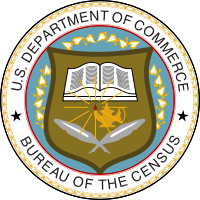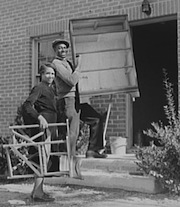Research Examines the Racial Disparity in Breastfeeding Rates
The African American mothers interviewed for the study for the most part wanted to breastfeed but were hampered by systemic, institutional and cultural barriers. Limited family leave and the demands of school made it difficult for many to meet their breastfeeding goals.
New Report From The College Board Examines the Racial Gap in Educational Attainment and...
The data shows that as Blacks move up the educational ladder, the racial earnings gap tends to diminish for younger workers. The report also shows that Blacks over the age of 25 with a bachelor's degree or higher in 2015 were more likely to be in the labor force than Whites.
Addressing the Issue of Mistrust Among Black Men for the Medical Establishment
Scholars at Stanford University and the University of Tennessee have published a working paper through the National Bureau of Economic Research that examines the lingering effect of distrust for the medical establishment among African American men today resulting from the Tuskegee Syphilis Experiment.
Study Finds a Direct Link Between Neighborhood Status and Health for African Americans
The analysis compared health data from participants in the Jackson [Mississippi] Heart Study to neighborhood poverty, unemployment, and other socioeconomic indicators from the 2000 U.S. Census and other data on violence and disorder.
More Evidence That Racism and Discrimination Can Negatively Impact Health of African Americans
A study led by researchers at the University of Florida found that genetic variants that predispose some people to depression, anxiety, or suicide might also make them more sensitive to the effects of discrimination and lead to higher blood pressure.
Black Scholar Develops a Smartphone App to Estimate a User’s Blood Alcohol Level
Emmanuel Agu, an associate professor of computer science at Worcester Polytechnic Institute in Massachusetts, is developing AlcoGait, a smartphone app that can accurately predict a user's level of intoxication by monitoring how he or she walks.
Study Finds That Young Children Can Learn Biases Through Nonverbal Signals From Adults
The research by psychologists at the University of Washington found that young children can perceive bias by parents and other adults they interact with through tone of voice or facial expressions.
Study Finds Everyday Discrimination Associated With Elevated Health Risks
Researchers interviewed a large group of African American adults in Milwaukee on their experiences with everyday racism. They also took blood, urine, and saliva samples to test for biomarkers of elevated disease risk.
UCLA Research Shows Infants Are Aware of Ethnic Differences of People They See
A group of infants were shown two photographs of women of different ethnicities on a computer screen. Using technology that tracks eye movements, the researchers were able to measure which photograph the infants were looking at and for how long.
Black Youth Exposed to More Junk Food Ads on TV Than White Youth
A new study by researchers at the Rudd Center for Food Policy and Obesity at the University of Connecticut finds that the number of junk food advertisements seen by Black youth rose 30 percent between 2008 and 2012. There was an 18 percent increase for White youth.
Academic Study Finds Racial Bias in Death Penalty Cases: But It May Not Be...
The study led by researchers at Michigan State University found that the race of the defendant does not have much impact in death penalty cases. But defendants were twice as likely to receive the death penalty if the victim was White than if the victim was Black.
Huge Racial Differences in Number of Children Living With Both Parents
The statistics show that 74.3 percent of all White children below the age of 18 live with both parents. This is true for only 38.7 percent of African American families. More than one third of all Black children in the United States under the age of 18 live with mothers who have never been married.
Black Directors of Methadone Clinics Are the Least Likely to Dispense Recommended Minimum Doses
A study led by a researcher at Johns Hopkins University finds that at methadone treatment facilities run by African American directors, patients are less likely to receive the recommended minimum dose than at facilities directed by managers of other races or ethnic groups.
Student Loan Debt Is a Major Problem for Large Numbers of HBCU Students
The data shows that 80 percent of all students at HBCUs borrow money under federal student loan programs. One quarter of all HBCUs graduates had student loan debt of more than $40,000. This is four times the rate of non-HBCU graduates.
Sociologist at the University of Connecticut Finds Bias in Hiring at Environmental Organizations
The study, authored by Maya Beasley, found that nearly 90 percent of the search consultants commonly used to find high-level executives for environmental organizations have encountered bias at the organizations that were seeking new employees.
A Unique Approach to Address the Racial Gap in School Discipline
Researchers at the University of Virginia, Rutgers University and the University of British Columbia have a published a study that shows that teachers who change instruction practices can impact the large racial gap in school discipline.
Study Documents the Severity of the Racial Gap in Dentistry
The study, by researchers at the University of California, San Francisco, and in the dental department of Bronx-Lebanon Hospital in New York, found that for racial parity to prevail with the Black population, an additional 19,714 African American dentists would be needed.
Student-Faculty Interactions Have a Major Impact on Students’ Perceptions of a Welcoming Campus
The results show that nine of the 12 types of student-faculty interactions had a statistically significant association with a student's perception of the overall campus climate regarding diversity. Five student-faculty interactions had a positive impact and four had a negative impact.
Study Finds Large But Narrowing Racial Divide in Residential Racial Segregation
A recent study by researchers at Pennsylvania State University finds that despite a narrowing in the racial poverty gap, Blacks and Hispanics still are significantly more likely than Whites to live in high-poverty neighborhoods.
Racial Differences in Food and Housing Insecurity Among Community College Students
The data from a study conducted at San Diego State University showed that among community college students 48.4 percent of Black men and 41.1 percent of Black women expressed housing insecurity. Black men also had a very high level of food insecurity.
University of New Hampshire Research Shows the Downward Trend in the White Population
A new study by researchers at the Carsey School of Public Policy at the University of New Hampshire finds that in 17 U.S. states the number of Whites who died in 2014 was higher than the number of Whites born in these states.
University Study Examines Differences in Cancer Mortality Among Blacks
The research, conducted by scientists at the University of Nevada Las Vegas, found that among all major racial/ethnic groups in the United States, American-born Blacks had the highest rate of cancer mortality. Caribbean-born Blacks in the United States had the lowest rate.
Research Finds That the Racial Earnings Gap for Men Has Returned to 1950s Level
The authors explain that the changing economy has been difficult for all workers with less than a high school education but has been particularly devastating for Black men. They found that in 1960, 19 percent of Black men were not working. By 2014, 35 percent of Black men were not employed.
Latest Data on African American Degree Awards From U.S. Colleges and Universities
A new report from the U.S. Department of Education shows that in the 2014-15 academic year African Americans earned 340,946 degrees and certificates from four-year institutions. They made up 10.5 percent of all individuals who were given degrees or certificates from four-year institutions.
A Sharp Drop in the Number of Americans Studying Abroad in Africa
According to new data from the Institute of International Education, the number of Americans studying abroad in sub-Saharan Africa in the 2014-15 academic year declined by nearly 20 percent from the previous year. In West Africa the decline was 67.6 percent.
Do Racial Stereotypes Impact Teachers’ Communication With Parents?
A new study by a scholar at the Steinhardt School of Culture, Education, and Human Development at New York University finds that many teachers communicate differently with parents depending on the race and immigrant status of their students.
Racial Differences in Mobility Rates in the United States by Educational Attainment
The racial gap in moving rates is significantly higher for those with lower levels of education. For Blacks and Whites with graduate or professional degrees, the difference is moving rates is only slightly higher for African Americans.
Students From Sub-Saharan African Nations at U.S. Colleges and Universities, 2015-16
The Institute for International Education reports that in the 2015-16 academic year, there were 35,364 students from sub-Saharan Africa enrolled at colleges and universities in the United States.
Are People Racist Against Places They Believe Are Associated With Blacks?
A new study by researchers at Stanford University, the University of Waterloo, and the University of Illinois at Chicago finds that while people may treat African Americans with racial bias, they are also likely to devalue and demean places associated with African Americans.
Academic Study Finds Possible Racial Bias by Mental Health Professionals
When a caller used the name Allison, she was invited to talk to the practitioner 63 percent of the time. When the name Lakisha was used by the same caller, she got through to the mental health professional 51 percent of the time.
A Healthy Increase in Black Students at U.S. Medical Schools
This year 21,020 students entered medical school for the first time. Of these, 1,771 identified themselves as Black or African American. This is an increase of nearly 27 percent from three years ago. In 2016, Blacks made up 8.4 percent of new entrants to U.S. medical schools.
New Study Finds Racial Segregation Is Firmly Established in the Nation’s Preschools
More than one fifth of all White preschoolers attend schools that are all White or nearly all White. A majority of Black and Hispanic students attend preschools where more than half of the students are from their own racial or ethnic group.
Explaining the Lack of Black Head Coaches in College Football
While there might be some merit to the theory of systematic racism in NCAA head coaching hires, other factors also come into play and have a major impact on why there are not more Black head coaches in college football.
The Racial Gap in High School Dropout Rates and Completion Rates
The data shows that in 2013, 9 percent of all African Americans ages 16 to 24 were not enrolled in schools and did not have a high graduation credential. For Whites, the figure was 4.7 percent. The racial gap is much larger when we compare those who completed high school in the traditional four-year timeframe.
Does Race Cloud Teachers Decisions on Student Assignments to Special Education?
A new study by Rachel Fish, an assistant professor at the Steinhardt School of Culture, Education, and Human Development at New York University, finds that race is a major factor in whether teachers recommend students for either gifted education programs or special education programs.
University Study Finds a Rise in “Global Neighborhoods” in U.S. Urban Areas
A study by researchers at Brown University in Providence, Rhode Island and the University of Wisconsin-Whitewater finds large numbers of urban areas with a very diverse populations. But they also found a major increase in the number of what they call "all minority" neighborhoods.




















































